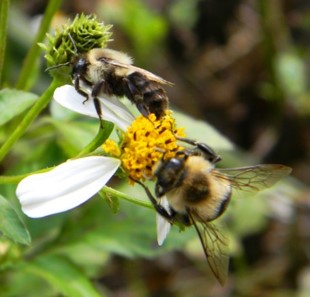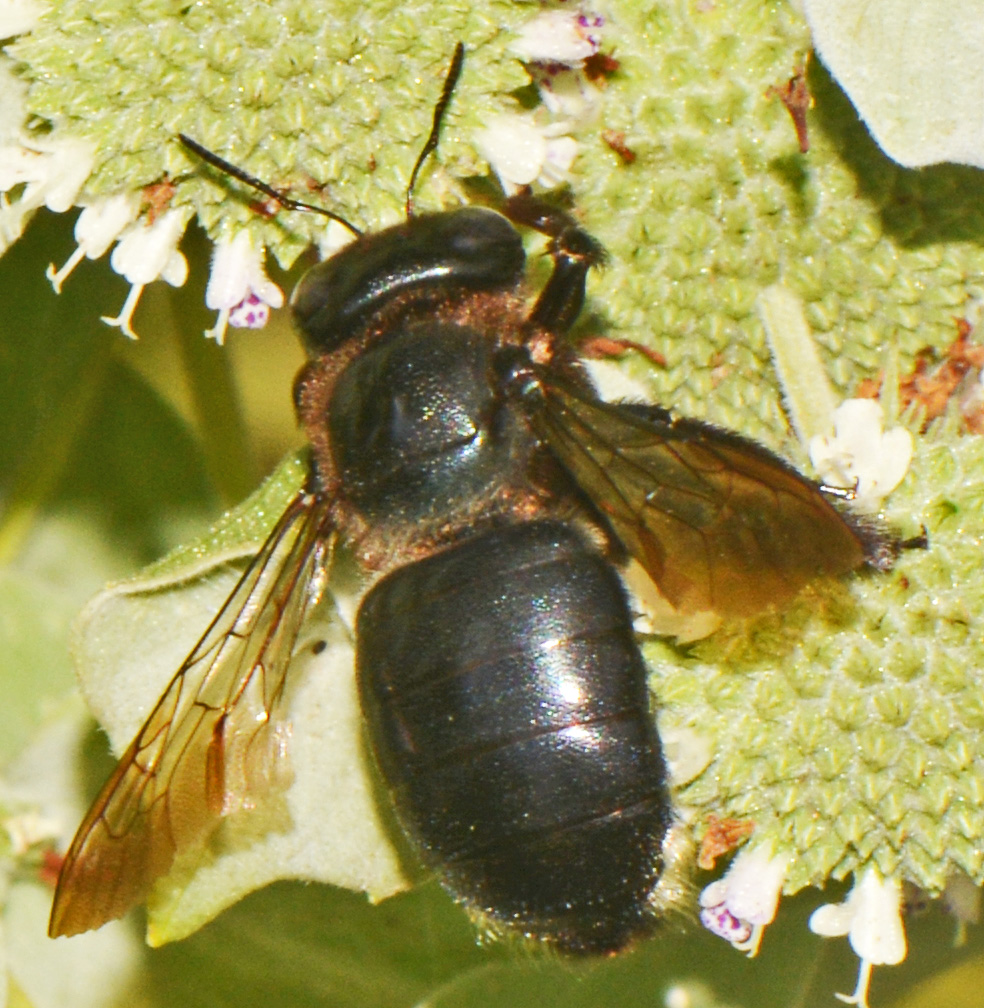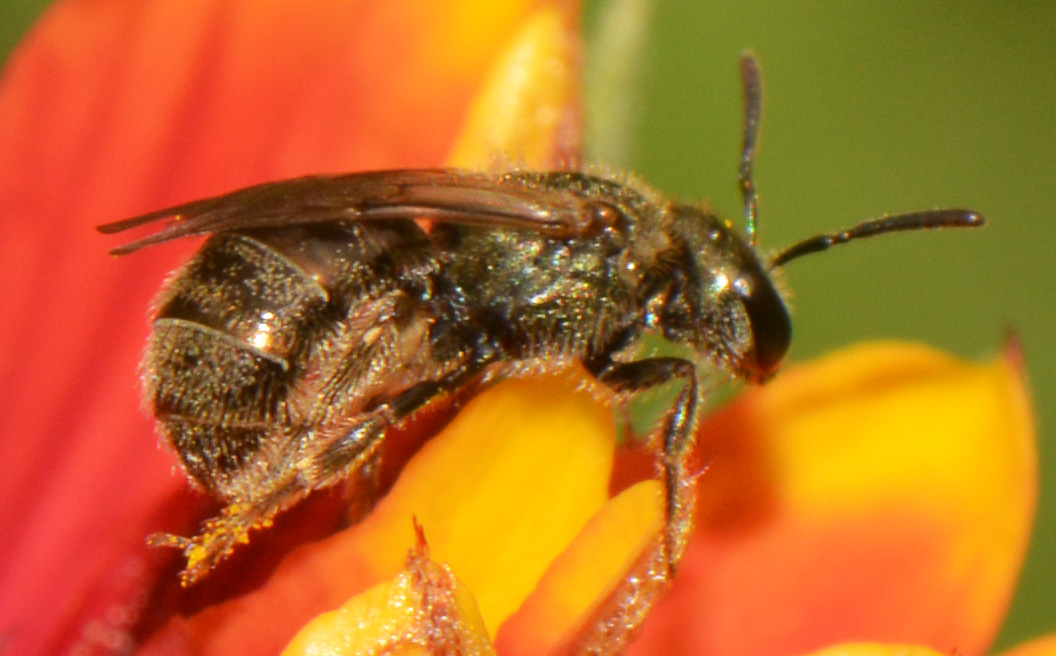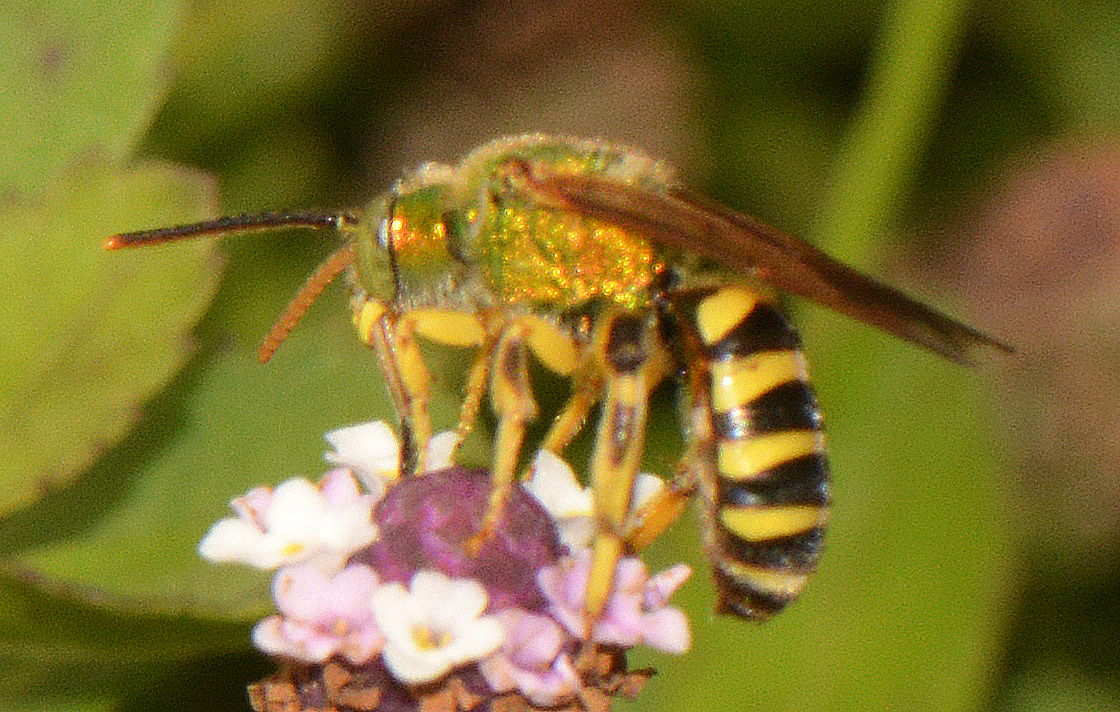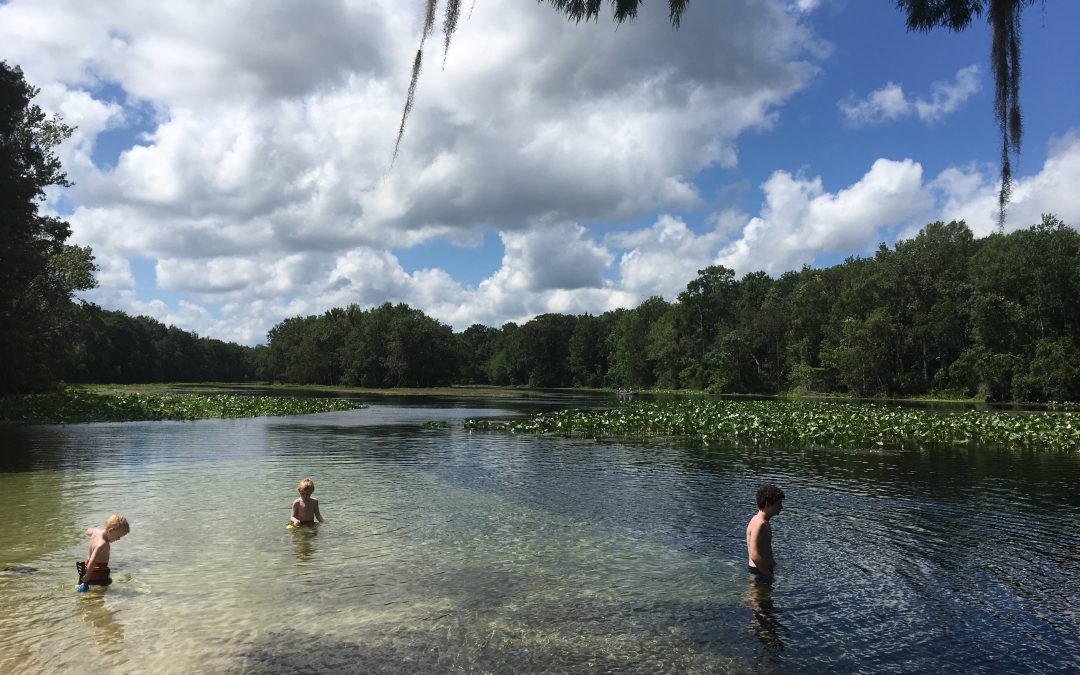
by Les Harrison | Sep 28, 2018
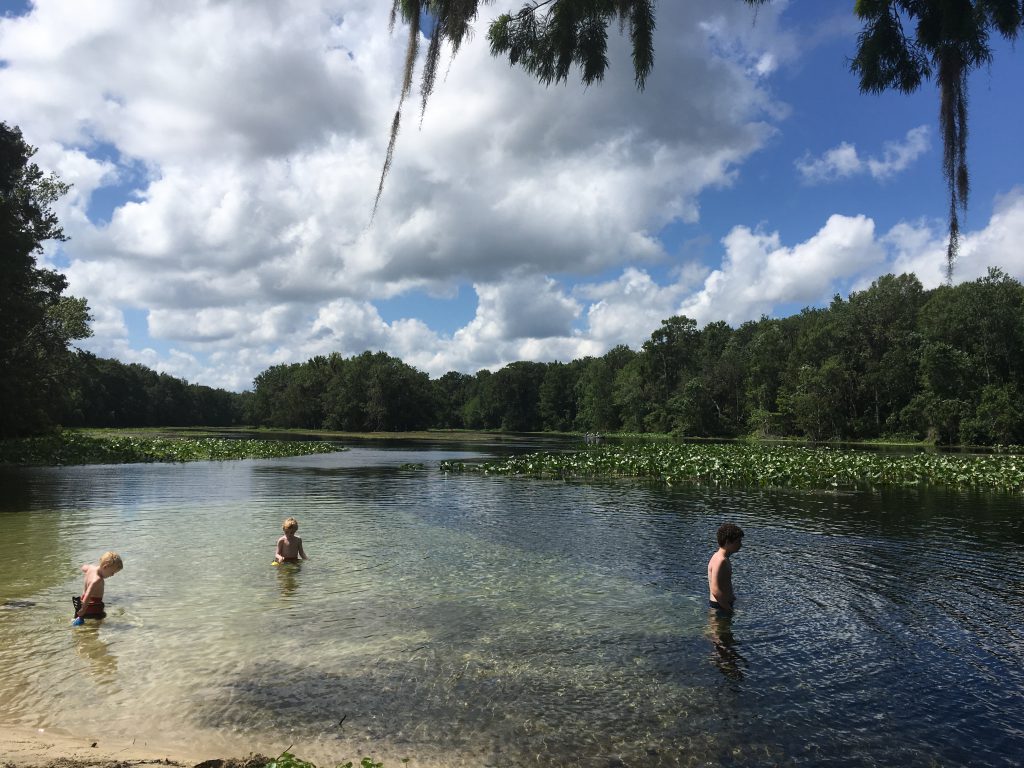
The Wacissa River offers paddlers the opportunity to see north Florida unfiltered.
Being off the beaten path has many advantages. In the case of a spring-fed river, it translates to less pressure from human use and a great opportunity for those who do visit to experience the “real Florida”.
The Wacissa River, located in the southern half of Jefferson County, Florida, is near the crossroads identified as the town of Wacissa. There is a blinking light, a post office, and two small convenience stores where beer, ice and snacks can be purchased.
Access to the river is about two miles south of the blinking light on Florida 59, just after the state road veers to the southwest. The blacktop spur quickly become a dirt parking lot after passing several canoe and kayak rental businesses.
A county maintained boat landing with pick-nic tables, a manmade beach, and a tiny diving platform with a rope swing are the only signs of civilization. The cold, clear water extends to a tree line several hundred yards south of the landing with the river moving to the southeast.
The river emerges crystal clear from multiple limestone springs along the first mile and a half of the 12 mile waterway. The adjacent land is flat and subject to being swampy, especially in wet years like 2018.
The river terrain stands in contrast to the Cody Scarp just a few miles to the north. This geologic feature is the remnants of an ancient marine terrace and is hilly, rising 100 feet above the river in some spots.
Cypress, oak, pine, and other trees cover the bottomlands adjacent to the river. The river quickly enters the Aucilla Wildlife Management Area which results in a wide variety of animals, birds, amphibians and reptiles.
The wildlife viewing varies by season. Many migratory birds use the river’s shelter and resources on their annual trips.
Canoeing and kayaking are popular in the gentle current. Powerboats and fan boats can use the area also, but must be on constant alert for shallow spots and hidden snags.
For the adventurous paddler who wants to follow the river’s course, there is a debarkation point at Goose Pasture Campgrounds and another near St. Marks after the Wacissa merges with the Aucilla.
Be prepared when taking this journey. This is the real Florida, no fast food restaurants or convenience stores. Only clear water, big trees and the calls of birds will be found here.
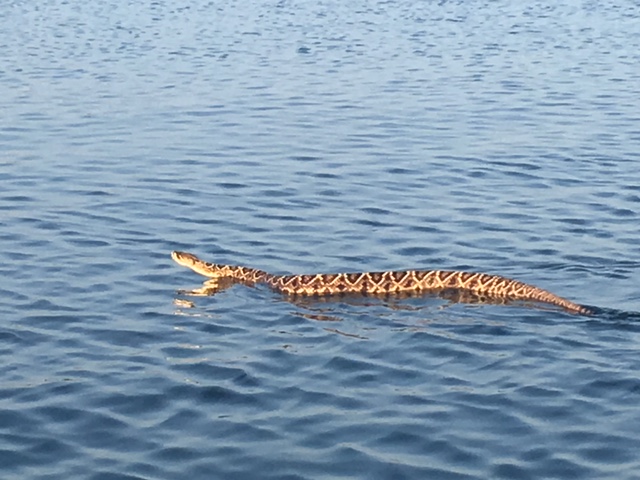
by Rick O'Connor | Sep 28, 2018
In the past week, three eastern diamondback rattlesnakes were encountered near the Ft. Pickens area on Pensacola Beach. The first was at a condominium unit near the park gate where construction work was occurring, the second was found swimming in the surf of the Gulf of Mexico within the national seashore, and the third was in the national seashore’s campground. This is an animal we rarely encounter on our barrier islands – but that is the keyword… encounter… they are there, but tend to avoid us.
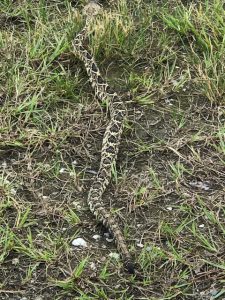
Eastern diamondback rattlesnake crawling near Ft. Pickens Campground.
Photo: Shelley Johnson
Report on rattlesnake in Gulf surf –
https://www.pnj.com/story/news/local/2018/09/26/snake-rescue-pensacola-beach-shocks-visitors/1430731002/
The eastern diamondback rattlesnakes (Crotalus adamanteus) is the largest venomous snake in the United States. An average snake will reach six feet and five pounds, but they can reach eight feet and up to 15 pounds. Because of their large bodies, they tend to move slow and do not often try to escape when approached by humans. Rather, they lie still and quite hoping to be missed. If they do feel you have come to close, they will give their signature rattle as a warning – though this does not always happen. If they are considering the idea of striking – they will raise their head in the classic “S” formation. Know that their strike range is 2/3 their body length – larger than many other native snakes – so a four foot snake could have a three foot strike range. Give these snakes plenty of clearance.
Eastern diamondback rattlesnakes prefer dry sandy habitats, though they are also found in pine flatwoods (such as Naval Live Oaks north of highway 98 in Gulf Breeze). They are quite common in the upland sandhills of longleaf pine forests. They spend the day in tree stump holes and gopher burrows and hunt small mammals and birds in the evenings. They are particular fond of rabbits. The dunes of our barrier islands are very similar to the sandhills of the pine forest further north. They are actually good swimmers and saltwater is not a barrier – distance is. They have been seen numerous times swimming from Gulf to Pensacola Beach or the opposite. Again, they tend to avoid encounters with humans and are not often found on lawns etc.
Diamondbacks give birth to live young around August. The females will find a dark-cool location to den and give birth several young. Anywhere from four to 32 offspring have been reported. The female remains with the young for about 10 days until they have their first molt (skin shedding) and then she leaves them to their fate.
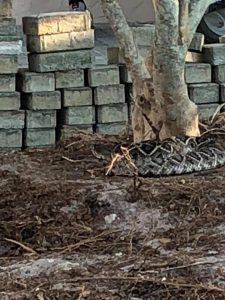
Diamondback rattlesnake near condominium construction site Pensacola Beach.
Photo: Sawyer Asmar
So what’s up with three encounters in a relatively small location within one week?
My first inclination is two possibilities – maybe a combination of the two.
- We have had a lot of rain this year – and then T.S. Gordon came through. Snakes like to be on high dry ground as much as anyone else and they tend to move closer to human habitats because they are built on higher ground.
- Breeding season for eastern diamondbacks is late summer early fall. This time of year, the males are on the move seeking interested females – so they are encountered more.
As far as finding one in the surf of the Gulf of Mexico. I am not sure. I have never seen this and the newspaper account suggested it was not doing well when found. Again, I have seen plenty swimming the Intracoastal but this is a first for the Gulf. I would say it had wondered the wrong way.
They are actually fascinating animals and are not a threat unless you approach too close. Give them room and feel lucky if you get to see one.
References
Eastern Diamondback Rattlesnake. Natural History. Center for Biological Diversity. https://www.biologicaldiversity.org/species/reptiles/eastern_diamondback_rattlesnake/natural_history.html.
Krysko, Kenneth L., and F. Wayne King. 2014. Online Guide to the Snakes of Florida. Florida Museum of Natural History, University of Florida, Gainesville, FL, USA. [Online: September 2014] Available at: http://www.flmnh.ufl.edu/herpetology.
https://www.floridamuseum.ufl.edu/herpetology/fl-snakes/list/crotalus-adamanteus.
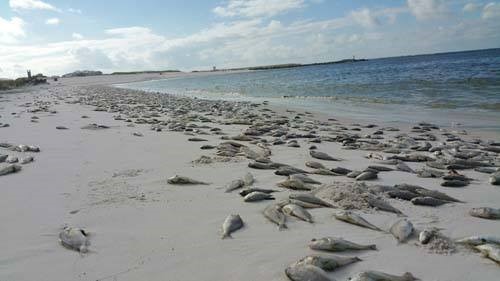
by Rick O'Connor | Sep 21, 2018
When I was in high school we were required to take a semester of communism during our senior year – the idea was to “know the enemy”. That is what we plan to do here… But, the enemy is a microscopic plant.
Its name is Karenia brevis. It is one of about 10 species of Karenia found in the ocean but it is the dominant form in the Gulf of Mexico. Karenia is referred to as “phytoplankton”, which suggests it is a microscopic plant. But in fact, it is in the Kingdom Protisita, not Plantae.
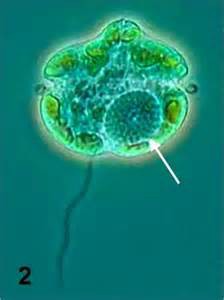
The dinoflagellate Karenia brevis.
Photo: Smithsonian Marine Station-Ft. Pierce FL
It is “plant-like” in that it has chlorophyll and can produce its own food. It differs in that it is a single cell. They are a type of phytoplankton called “dinoflagellates” because they have two flagella. The next question of course is what is flagella? It is a hair-like structure used by the cells for location. Though they can swim, they cannot out swim a current and so drift in the ocean – using their flagella to move up and down within the current and orient themselves.
The cell is covered with a protective shell called a theca, which as grooves, known as girdles, in which the flagella lie – one running east-west, the other north-south. They are between 18-45 microns long with the north-south flagella extending to look like a tail. They are members of the Gulf of Mexico community. Always out there, always have been. Typically, a plankton sample might find 1000 cells / liter. At these concentrations there does not seem to be a problem.
A problem?
What’s the problem?
The problem is that in its defense, K. brevis will release toxins. The toxin is a cocktail of lipophilic polyether compounds called brevotoxins. At low, or background concentrations, the levels of brevotoxins does not seem to effect marine organisms much at all. However, when the population of cells increases, to say 2 million / liter, fish kills can occur. The state of Florida will close shellfish harvesting if the concentrations reach 5000 / liter.
This brevotoxin is pretty strong stuff. It effects the nervous and immune systems, and effects the respiratory system. For marine vertebrates, it is deadly. At concentrations over 1,000,000 cells / liter, it can cause death for fish, dolphins, sea turtles, and manatees. Shellfish are filter feeders. During large blooms of K. brevis shellfish can consume enough to make humans very sick if they consume the shellfish.
So what causes their numbers to increase from 1000 to 1,000,000 cells / liter?
Summer…
Though K. brevis is not a plant, it is plant-like. Plants like sunlight and fertilizers. Warm shallow seas of southwest Florida are perfect. Nutrients are available in the environment and growth begins. Most blooms (large growth spurts) occur offshore. They love high salinities and not as common in our estuaries. However, they are plankton – wind and currents can move them closer to shore. During the raining season (summer) run-off from land brings with it nitrogen and phosphorus (nutrients) which can enhance a bloom. The fish kills begin, the respiratory problems for humans are annoying, and the tourist become concerned. Red tide can certainly have an impact on the local economy.
Globally, algal blooms seem to be increasing. Red tide can last a few days or a few months, each year varies. These are not exotic species; they are local Gulf residents who are finding warmer, saltier seas that they love. Algal blooms typically occur from September to February and though are common in southwest Florida, can extend across the Gulf to Texas – which the Florida panhandle is experiencing currently.
As Dr. Karl Havens mentions in his article attached, we cannot control the weather, but we can control the amount of nutrients we allow into our waterways. We should consider management practices that do just this to reduce the effects of these naturally occurring blooms.
Below are other articles from Sea Grant on this topic.
Frequently Asked Questions About the 2018 Red Tide Bloom – Betty Staugler, Florida Sea Grant
http://blogs.ifas.ufl.edu/charlotteco/2018/08/14/frequently-asked-questions-about-the-2018-red-tide-bloom/.
Understanding Florida’s Red Tide – Betty Staugler, Florida Sea Grant
https://www.flseagrant.org/news/2018/08/understanding-the-florida-red-tide/.
Watching and Waiting: Uncertainty About When the Algal Blooms Will End – Dr. Karl Haven, Florida Sea Grant
https://www.flseagrant.org/news/2018/07/watching-and-waiting-uncertainty-about-when-algae-blooms-will-end/.
REFERENCES
About Florida Red Tides. Florida Fish and Wildlife Conservation Commission. http://myfwc.com/research/redtide/general/about/.
Indian River Lagoon Species Inventory. Karenia brevis. Smithsonian Marine Station at Ft. Pierce. http://www.sms.si.edu/irlspec/Kareni_brevis.htm.
Pierce, R.H., M.S. Henry. 2008. Harmful Algal Toxins of the Florida Red Tide (Karenia brevis): natural chemical stressors in South Florida coastal ecosystems. Ecotoxicology. 17(7). Pp. 623-631. http://www.sms.si.edu/irlspec/Kareni_brevis.htm.
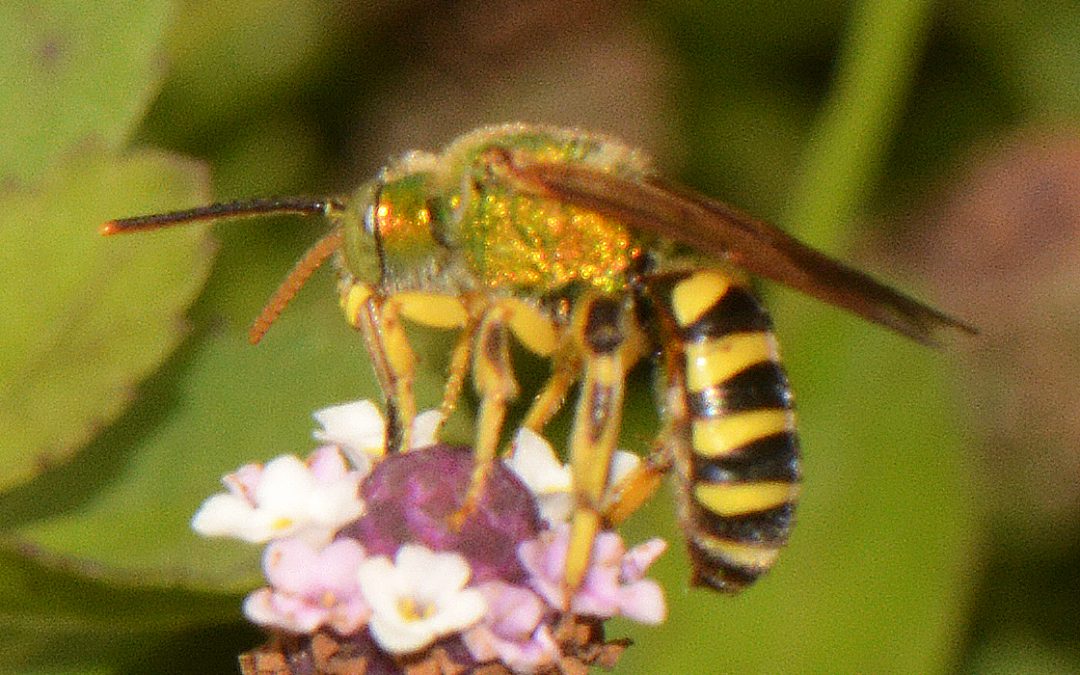
by Judy Biss | Sep 14, 2018
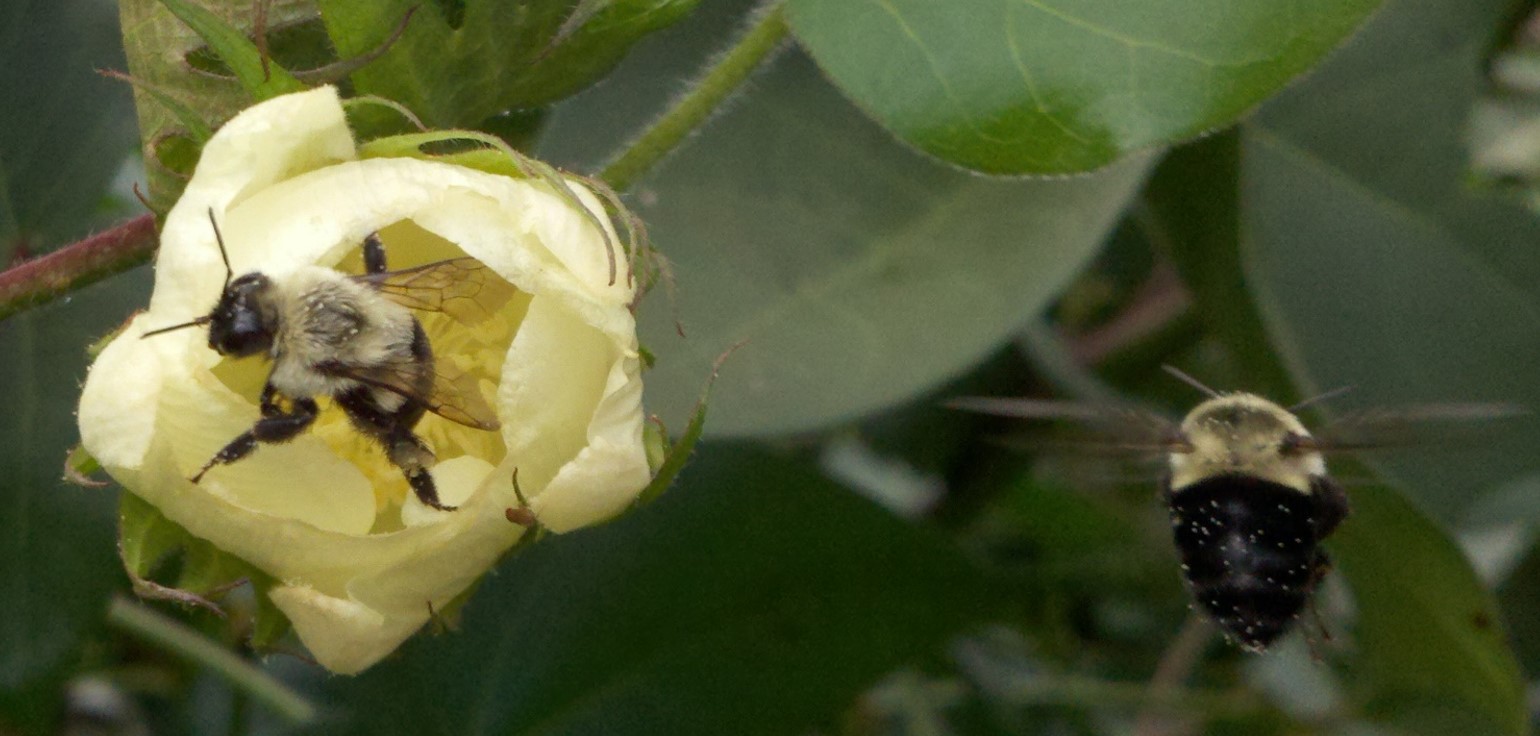
Bumble bees and other pollinators often visit the vast fields of cotton flowers in north Florida’s agricultural lands. Although cotton is mainly self-pollinating, pollination by bees can increase seed-set per cotton boll. Note the pollen grains stuck on each bee. Photo by Judy Biss
Beekeeping is thriving in Panhandle Florida and the importance of honeybee health and pollination is frequently in the news. As much as 1/3 of our food supply depends on the pollinating activities of honeybees, and because of this fact, pollinator protection was formally recognized at the federal level in 2014 when the President of the United States signed the memorandum called: Creating a Federal Strategy to Promote the Health of Honey Bees and Other Pollinators.
The goals of this policy are to increase and improve pollinator habitat for not only managed European honeybee colonies, but also native bees, birds, bats, and butterflies – all of which are vital to our nation’s economy, food production, and environmental health.
So, of the variety of pollinating insects and animals, what are some of Florida’s native pollinating bees? What do they look like and what are their characteristics? Let’s take a look at a few. Follow the links provided for additional, fascinating details. I will start with one of my favorites, because it happens to pollinate one of my favorite fruits. Blueberries!
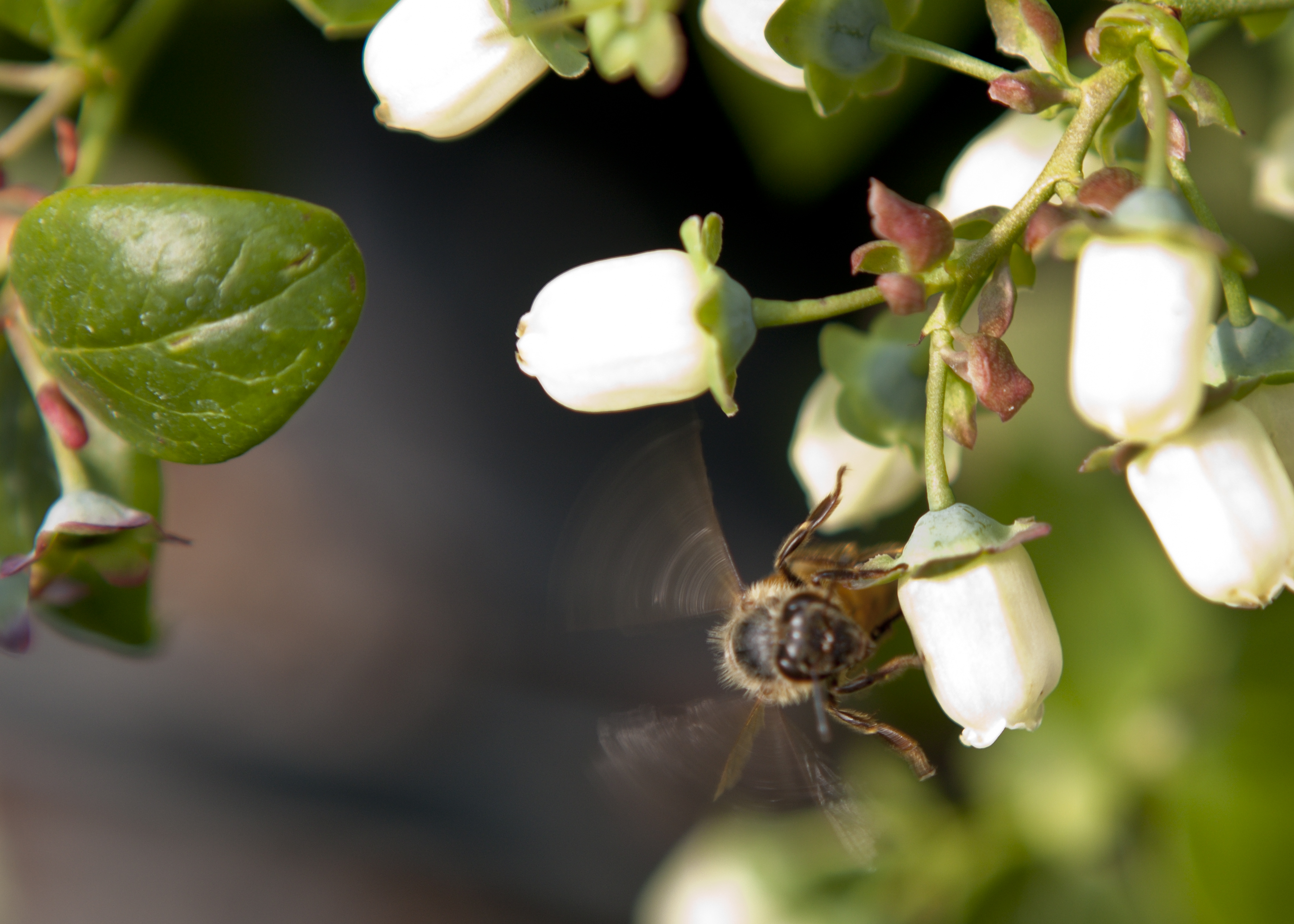
The Southeastern blueberry bee uses buzz pollination on a blueberry plant. Photo credit: UF/IFAS Photo by Tyler Jones.
While managed honeybees can pollinate blueberries, the Southeastern blueberry bee, as well as bumblebees, are much more efficient pollinators of this crop. These bees “sonicate” the flowers to release more pollen. Sonication, or buzz pollination is caused by the bee’s high-speed wing beats vibrating the flower causing pollen to fall onto the bee. As we will see with many of our native bees, the Southeastern Blueberry bee is a solitary bee meaning it does not live in colonies like the European honeybee. The Southeastern Blueberry bee digs burrows in the ground where they lay eggs that hatch the following year to start the cycle over again.

Male blue orchard bee. Males have long antennae. Credit: Kevin Hall, BugGuide.net
Blue orchard bees are native to the United States and Canada, and are important pollinators of a variety of fruits including blueberries. They are solitary bees most active in the early spring and summer. They are part of a group of bees called mason bees that use holes or tube-like structures to nest in. Some garden supply stores now carry native bee nesting cavities such as stacks of bamboo or blocks of wood with holes of varying sizes that you can use to attract these native pollinators to your backyard.
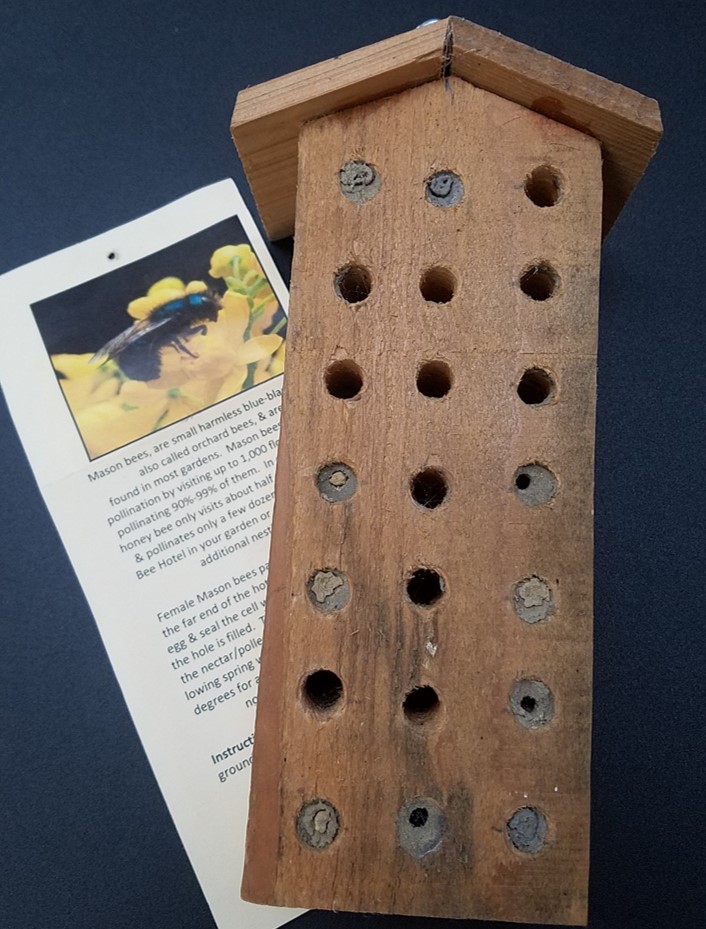
Many native pollinating bees, such as the mason bees, are solitary in nature and can be attracted to your backyard by providing nesting habitat. Bee nesting “houses,” such as this block of wood with pre-drilled holes, are available for sale more frequently now in garden supply stores. Note the cavities that were used indicated by the mud-like plugs. Photo by Judy Biss

Nesting area of the miner bee, Anthophora abrupta Say. Photograph by Jason Graham, University of Florida.
A few years ago, our office received a call about a number of bees flying around a large pile of fill dirt in one of our local parks. It turned out to be the nesting site of these fascinating bees. These bees are solitary, yet gregarious. Solitary in that the female builds her own burrow in the ground in which to lay her egg; gregarious in that they tend to congregate together to build their individual burrows. They are pollinators of a number of plants, including fruits and vegetables.
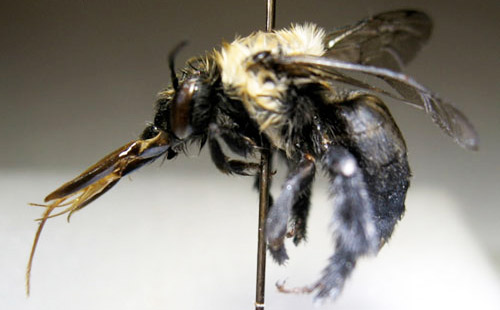
Adult female Anthophora abrupta Say, a miner bee. Photograph by Katie Buckley, University of Florida.
Bumble bees are among the most recognizable of insects. They are large, colorful, and a wonder to watch. They are also important pollinators of both native plants and agricultural crops. Bumble bees are so effective at pollinating important food crops, they are raised commercially and sold to pollinate produce such as tomatoes, peppers, cranberries, and strawberries. Blueberries and other commercially important food crops benefit from the bumblebees’ ability to “sonicate,” or “buzz pollinate,” as described above. They are social bees forming small colonies (50 – 500 individuals) in the ground or empty cavities, which only last one season.
Leafcutting bees are a group of important native pollinators found throughout the world, including North America. In Florida, there are approximately 63 different species of leafcutting bees, one of which is Osmia lignaria listed above (Blue Orchard Bee). As the name implies, these solitary bees cut neat circles from broadleaf deciduous plants which they use to build their long tubular nests. While their leaf cutting capabilities can sometimes decrease the esthetics of some common landscape plants, their actions will not harm the plants. They are pollinators of wildflowers and many of our fruits and vegetables.

Typical leaf damage caused by leafcutting bees, Megachile spp. The bees use the leaf pieces to construct nests. Photograph by L.J. Buss, University of Florida.
Sweat bees are important pollinators for many wildflowers and fruits and vegetables, including peaches, plums, apples, pears, alfalfa and sunflower. This family of bees (Halictidae) contains one of the largest genera of bees in the world, displaying a wide range of social, nesting, physical, and foraging characteristics. In Florida, there are 44 species of sweat bees.
So, the next time you are walking in the garden, or hiking in Florida’s beautiful woodlands and pastures, slow down to catch of glimpse of these busy and critically important insect pollinators. I for one am quite grateful for those bees that help produce an abundance of food… especially blueberries!
For more information, check out the following resources:
Calhoun County Florida Wasps and Flies
Love Blueberries? Thank the Blueberry Bee!
USDA Forest Service publication: “Bee Basics—An Introduction to our Native Bees,”
UF/IFAS Entomology and FDACS Featured Creatures
The Bumble Bee – One of Florida’s Vital Pollinators
Blue Orchard Bee, Osmia lignaria Say (Insecta: Hymenoptera: Megachilidae)
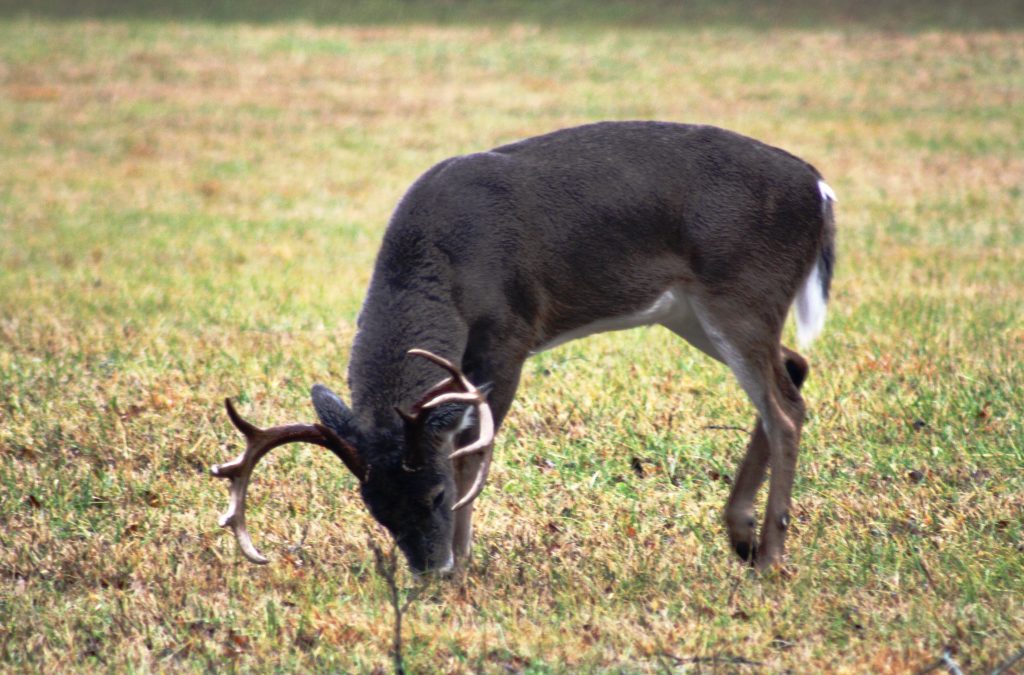
by Shep Eubanks | Sep 12, 2018
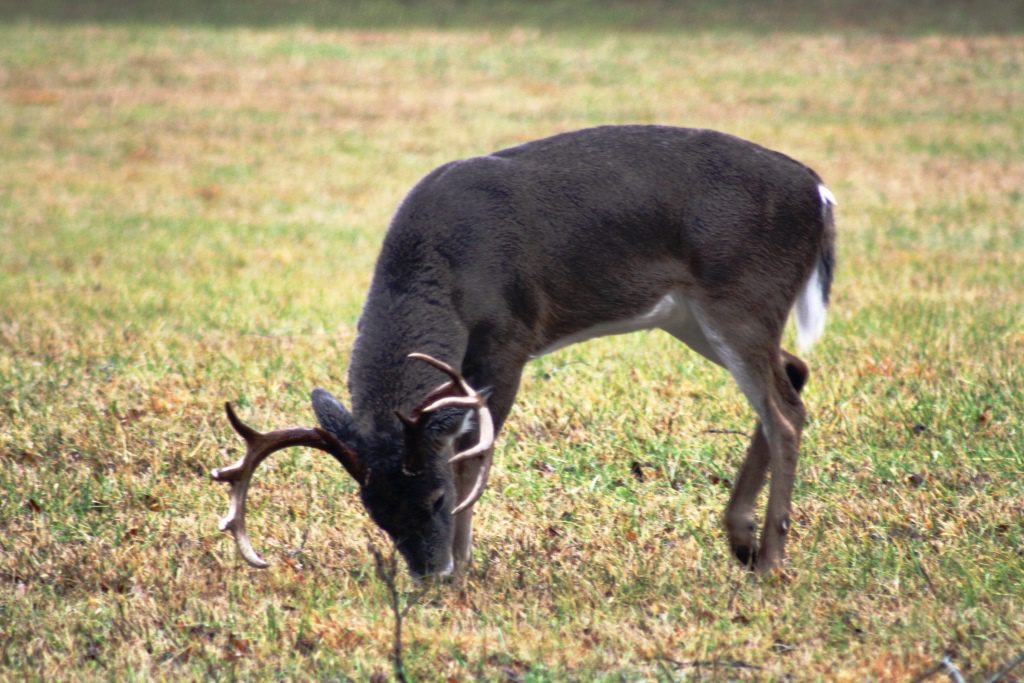
North Florida buck feeding on acorns at the edge of a food plot. Photo Credit – Shep Eubanks UF/IFAS
It’s that time of year when landowners, hunters, and other wildlife enthusiasts begin to plan and prepare fall and winter food plots to attract wildlife like the nice buck in the photo.
Annual food plots are expensive and labor intensive to plant every year and with that thought in mind, an option you may want to consider is planting mast producing crops around your property to improve your wildlife habitat. Mast producing species are of two types of species, “hard mast” (oaks, chestnut, hickory, chinkapin, American Beech, etc.), and “soft mast” (crabapple, persimmon, grape, apple, blackberry, pears, plums, pawpaws, etc.). There are many mast producing trees and shrubs that can be utilized and will provide food and cover for a variety of wildlife species. This article will focus on two, sawtooth oak (or other oaks) and southern crabapple.
Sawtooth Oak
Oaks are of tremendous importance to wildlife and there are dozens of species in the United States. In many areas acorns comprise 25 to 50% of a wild turkeys diet in the fall (see photos 1, 2, and 3) and probably 50% of the whitetail deer diet as well during fall and winter. White oak acorns average around 6% crude protein versus 4.5% to 5% in red oak acorns. These acorns are also around 50% carbohydrates and 4% fat for white oak and 6% fat for red oak.
The Sawtooth Oak is in the Red Oak family and typically produces acorns annually once they are mature. The acorns are comparable to white oak acorns in terms of deer preference as compared to many other red oak species. Most red oak acorns are high in tannins reducing palatability but this does not seem to hold true for sawtooth oak. They are a very quick maturing species and will normally begin bearing around 8 years of age. The acorn production at maturity is prolific as you can see in the photo and can reach over 1,000 pounds per tree in a good year when fully mature. They can reach a mature height of 50 to 70 feet. There are two varieties of sawtooth oak, the original sawtooth and the Gobbler sawtooth oak, which has a smaller acorn that is better suited for wild turkeys. The average lifespan of the sawtooth oak is about 50 years
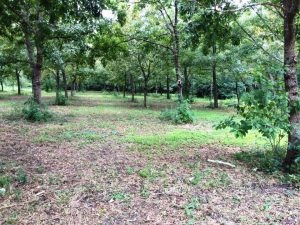
Photo 1 – Seventeen year old planting of sawtooth oaks in Gadsden County Florida. Photo Credit – Shep Eubanks UF/IFAS

Photo 2 – Gadsden County gobblers feeding on Gobbler sawtooth oak acorns
Photo Credit – Shep Eubanks UF/IFAS
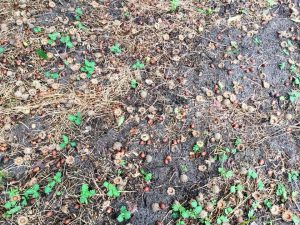
Photo 3 – Gobbler sawtooth oak acorns in Gadsden County. Notice the smaller size compared to the regular sawtooth oak acorn which is the size of a white oak acorn.
Photo credit – Shep Eubanks UF/IFAS
Southern Crabapple
Southern Crabapple is one of 25 species of the genus Malus that includes apples. They generally are well adapted to well drained but moist soils and medium to heavy soil types. They will grow best in a pH range of 5.5 – 6.5 and prefer full sun but will grow in partial shade as can be seen in photo 4. They are very easy to establish and produce beautiful blooms in March and April in our area as seen in photo 5. There are many other varieties of crabapples such as Dolgo that are available on the market in addition to southern and will probably work very well in north Florida. The fruit on southern crabapple is typically yellow green to green and average 1 to 1.5 inches in diameter. They are relished by deer and normally fall from the tree in early October.
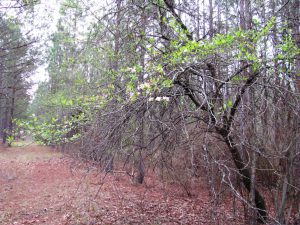
Photo 4 – Southern crabapple tree planted on edge of pine plantation stand. Photo taken in late March during bloom.
Photo credit – Shep Eubanks UF/IFAS
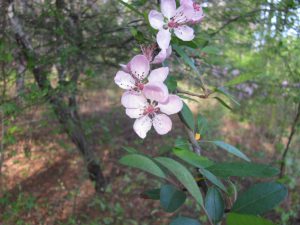
Photo 5 – Showy light pink to white bloom of southern crabapple in early April during bloom.
Photo credit – Shep Eubanks UF/IFAS
A good resource publication on general principles related o this topic is Establishing and Maintaining Wildlife Food Sources.
If you are interested in planting traditional fall food plots check out this excellent article by UF/IFAS Washingon Couny Extension Agent Mark Mauldin: Now’s the Time to Start Preparing for Cool-Season Food Plots .
For more information on getting started with food plots in your county contact your county’s UF/IFAS Extension Office















